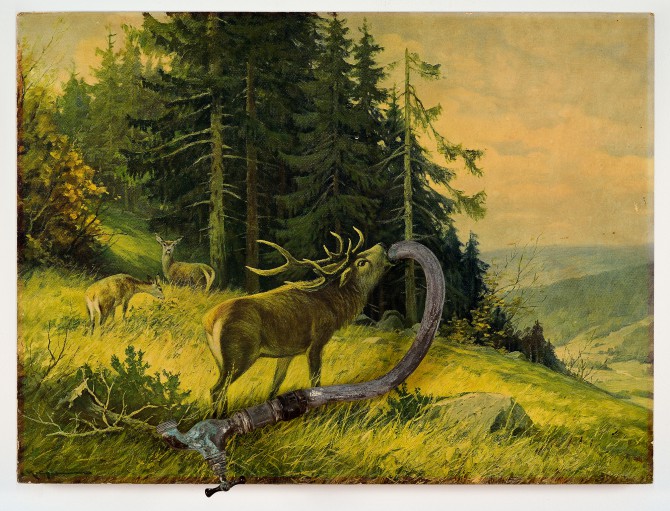Daniel Spoerri
Der rohrende Hirsch (The pipe belling stag)
1978, Offset printing/pipe with water cock, 59,3 x 78,8 x 11,5 cm
1978, Offset printing/pipe with water cock, 59,3 x 78,8 x 11,5 cm

La Pharmacie Bretonne
1981, Object box with healing water from Bretagne, Ed. 55,
104 x 81 x 16 cm
104 x 81 x 16 cm
1981, Object box with healing water from Bretagne, Ed. 55,
104 x 81 x 16 cm
104 x 81 x 16 cm

Biography
Born Daniel Isaac Feinstein in Galati/Romania in 1930.
1942 Flees to Zurich with his mother and five siblings after his father was deported to a Nazi extermination camp in the summer of 1941 and murdered there. In Switzerland, the family takes the mother's maiden name, Spoerri.
1949 Training at the Zurich Theatre Dance School.
1952 Scholarship to study ballet in Paris
1954-57 First dancer at the Bern City Theatre. Begins friendship with Dieter Roth, Bernhard Luginbühl, Claus Bremer, André Thomkins and Meret Oppenheim
1956 Stages Picasso's "How to Grab Wishes by the Tail" in Berne.
1958-59 Meets Pol Bury, Jesus-Rafael Soto, Marcel Duchamp, Man Ray and Robert Filliou
1960 Co-signs the manifesto of "Nouveau Réalisme". First trap paintings
1968 Opens the "Eat Art Galerie" above the Spoerri Restaurant, Düsseldorf
1971-72 Retrospectives in Amsterdam and Zurich
1983-89 Professorship at the Munich Art Academy.
1987 Guest lecturer at the University of Applied Arts, Vienna
1990-91 Retrospectives in Paris, Antibes, Vienna, Munich, Solothurn.
1993 The French state awards Spoerri the "Grand Prix National de la Sculpture".
2001 Retrospective at the Museum Tinguely, Basel
2013 Award from the French Ministry of Culture. Ministry of Culture "Commandeur de l'ordre des Arts et des Lettres".
2015 Participation in the World Expo, Milan
2016 Lovis Corinth Prize, Regensburg
2019 Symposium "Topographies de Daniel Spoerri: l'artiste en ses réseaux" at the German Forum for Art History, Paris
Lives and works in Vienna/Austria
Spoerri is one of the most important representatives of object art and is considered the founder of "Eat Art". He became known above all for his "Fallenbilder" ("tableaux pièges"). These remains of meals glued to tabletops are the artist's trademark. In 1960, when Spoerri was collecting metal parts for his artist friend Jean Tinguely, he had the idea of gluing the objects to a solid base and then tilting them vertically. It was the birth of the "tableaux-pièges", which basically immortalise the remains of a meal as reliefs - in some paintings there are hundreds of table utensils. Altering levels of perception and reality are an important aspect of his artistic work. This also includes the alienation of food. For him, this naturally includes questioning eating habits, sensory perceptions and traditions. With the "Restaurant Spoerri" and the accompanying "Eat Art Galerie", which he opened in Düsseldorf in 1968, the artist became the founder of "Eat Art". His art encompasses object art and process art, for the pasted moment is only one aspect of an overall cycle that includes life and death, decay and rebirth.
1942 Flees to Zurich with his mother and five siblings after his father was deported to a Nazi extermination camp in the summer of 1941 and murdered there. In Switzerland, the family takes the mother's maiden name, Spoerri.
1949 Training at the Zurich Theatre Dance School.
1952 Scholarship to study ballet in Paris
1954-57 First dancer at the Bern City Theatre. Begins friendship with Dieter Roth, Bernhard Luginbühl, Claus Bremer, André Thomkins and Meret Oppenheim
1956 Stages Picasso's "How to Grab Wishes by the Tail" in Berne.
1958-59 Meets Pol Bury, Jesus-Rafael Soto, Marcel Duchamp, Man Ray and Robert Filliou
1960 Co-signs the manifesto of "Nouveau Réalisme". First trap paintings
1968 Opens the "Eat Art Galerie" above the Spoerri Restaurant, Düsseldorf
1971-72 Retrospectives in Amsterdam and Zurich
1983-89 Professorship at the Munich Art Academy.
1987 Guest lecturer at the University of Applied Arts, Vienna
1990-91 Retrospectives in Paris, Antibes, Vienna, Munich, Solothurn.
1993 The French state awards Spoerri the "Grand Prix National de la Sculpture".
2001 Retrospective at the Museum Tinguely, Basel
2013 Award from the French Ministry of Culture. Ministry of Culture "Commandeur de l'ordre des Arts et des Lettres".
2015 Participation in the World Expo, Milan
2016 Lovis Corinth Prize, Regensburg
2019 Symposium "Topographies de Daniel Spoerri: l'artiste en ses réseaux" at the German Forum for Art History, Paris
Lives and works in Vienna/Austria
Spoerri is one of the most important representatives of object art and is considered the founder of "Eat Art". He became known above all for his "Fallenbilder" ("tableaux pièges"). These remains of meals glued to tabletops are the artist's trademark. In 1960, when Spoerri was collecting metal parts for his artist friend Jean Tinguely, he had the idea of gluing the objects to a solid base and then tilting them vertically. It was the birth of the "tableaux-pièges", which basically immortalise the remains of a meal as reliefs - in some paintings there are hundreds of table utensils. Altering levels of perception and reality are an important aspect of his artistic work. This also includes the alienation of food. For him, this naturally includes questioning eating habits, sensory perceptions and traditions. With the "Restaurant Spoerri" and the accompanying "Eat Art Galerie", which he opened in Düsseldorf in 1968, the artist became the founder of "Eat Art". His art encompasses object art and process art, for the pasted moment is only one aspect of an overall cycle that includes life and death, decay and rebirth.